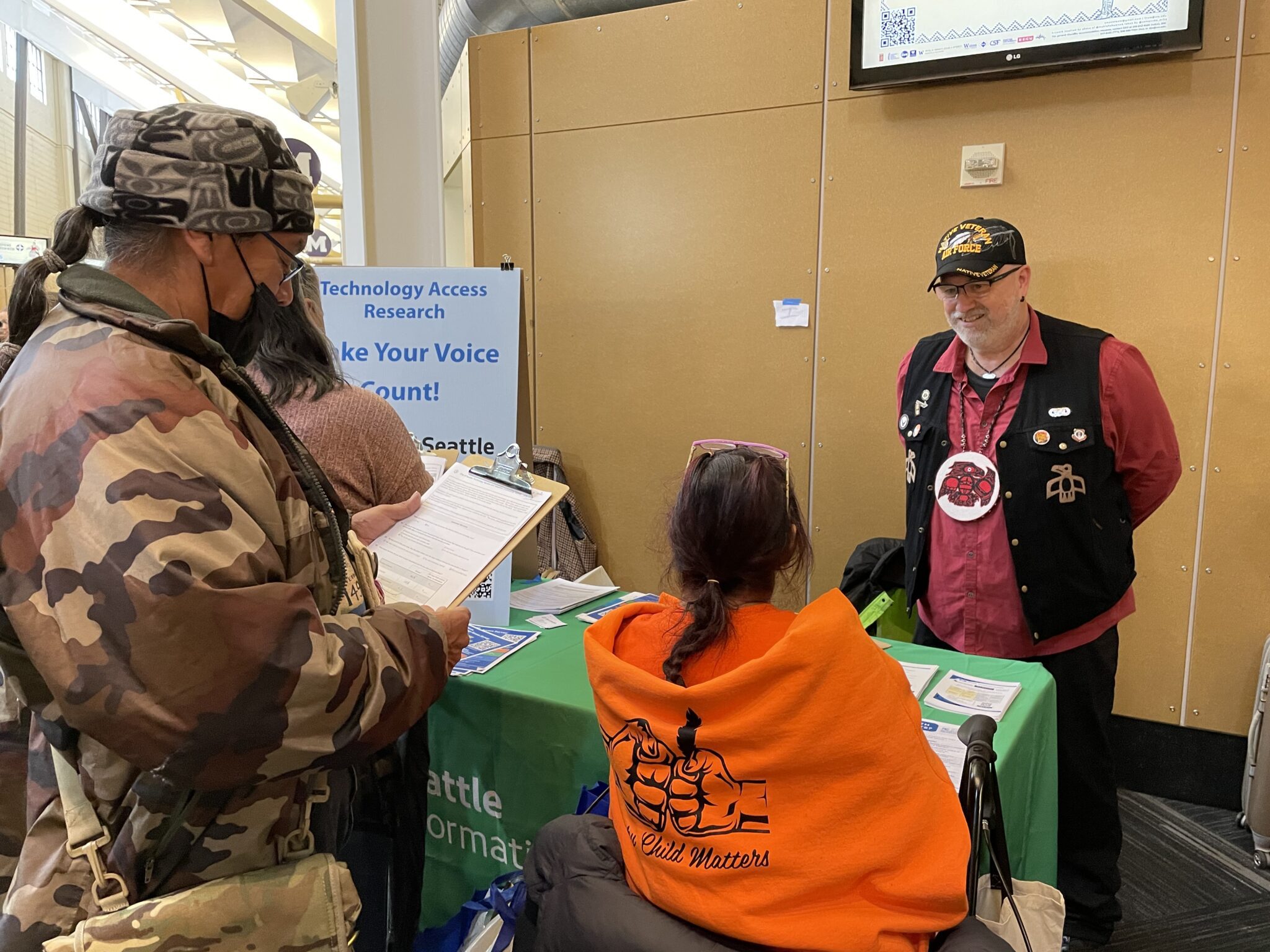 Will Booth from Tribal Technology Training (T3) collecting surveys at the Seattle Information Technology table at the UW Powwow.
Will Booth from Tribal Technology Training (T3) collecting surveys at the Seattle Information Technology table at the UW Powwow. The City of Seattle has released the Technology Access and Adoption Study thanks to the input of over 4,600 Seattle residents. The study, conducted every five years, provides valuable data and insight on internet access and use, devices, digital skills, civic participation, training needs, and safety and security concerns. Results help guide the City and community digital equity programs to serve residents better.
For the first time, the study reports on telehealth use, prolonged internet interruptions, adequate screen size, devices per household, and awareness of the Affordable Connectivity Program (ACP). In this survey, the City partnered with Native groups to gather the first-ever urban Native digital equity snapshot. Findings from this study reveal that while the digital divide has shrunk, there is still work to do to ensure all residents have resources and access to digital tools and training.
“Improving digital access, literacy, and equity is essential to our city’s future and is a cause I have championed for years,” said Mayor Bruce Harrell. “As we continue to build One Seattle, we must remember that a strong, thriving city encompasses many aspects, and the ability to get online easily for work, school, and just the daily tasks that are now rooted in our connected world is essential for successful, healthy families. I look forward to working with our community as we dig through this valuable data to develop further programs and partnerships that lead us to 100% connectivity for Seattle residents.”
The survey, conducted in eight languages, revealed that home internet access in Seattle has increased from 95% to 98% from the previous five years. However, significant disparities persist. An estimated 8,123 households within the City cannot access the internet at home. Those who do not speak English as their main language are four times more likely not to have internet access at home.
“As the chair of the new Parks, Public Utilities, and Technology Committee, I’m eager to dive into the data on this crucial topic. Connectivity is key for our families and communities today,” said Councilmember Joy Hollingsworth. “We are proud of the progress we have made in increasing digital equity; however, we must still look ahead to address remaining disparities. Understanding the data behind the work is critical as we look to revitalize our communities, support small businesses, improve the City’s infrastructure, and ensure all Seattle residents have the resources they need to thrive.”
This study includes two types of research: a citywide general population survey plus 40 focus groups. It measures progress since the pandemic and the last 2018 study. The study also assesses technology adoption changes, progress toward the City’s Internet for All initiative goals, and COVID-19 impacts on digital connectedness and use. The summary report contains findings from the survey, along with highlighted key findings and quotes from the focus groups.
“The City’s Technology Access and Adoption Report is a driving force for how we plan our partnerships and programming to support digital equity for our communities,” said Interim Chief Technology Officer Jim Loter. “This data-driven work will lay the foundation for our partnerships for several years. By partnering with key community groups to have a wider reach for the survey this year, I’m confident we can have a deeper impact in the work the City does to help our residents meet their digital needs.”
The survey, conducted in eight languages, was distributed with the help of Seattle Schools and Seattle Housing Authority and collected in person at events with the help of Tribal Technology Training (T-3). The City’s research partners were Olympic Research, Inclusive Data, and Pacific Market Research, as well as a wide range of community partners. Thanks to the impressive response, surveys were completed in all languages offered, and Seattle IT received enough completed surveys from the Native community to have a statistically valid sample.
The findings include that:
- One in 20 households have fewer than one internet device per household member.
- Over half (54%) are interested in training on how to protect yourself and your data online.
- 1 in 6 Native households dealt with internet outages of a month or more.
- 71% have made a health appointment online, but lower income residents use telehealth less.
- Nearly 44,000 households have significant needs for improvement in access, devices, uses and skills using a new digital connectedness index.
- 11% of BIPOC households do not have internet access both at home and on-the-go.
- Focus group participants expressed needs for training in-person, online and hybrid.
To learn more about the survey, including the full summary report, Tableau data dashboards, focus group results, and more, visit Seattle.gov/tech.
The Digital Equity program is a part of the Seattle Information Technology Department (Seattle IT). The Digital Equity program encompasses grant funding, the Digital Navigator Cohort, support for discounted cable TV, internet and devices, and more. Seattle IT is a trusted partner that provides secure, reliable, and compliant technologies, enabling the City to deliver equitable and responsive services to the public.